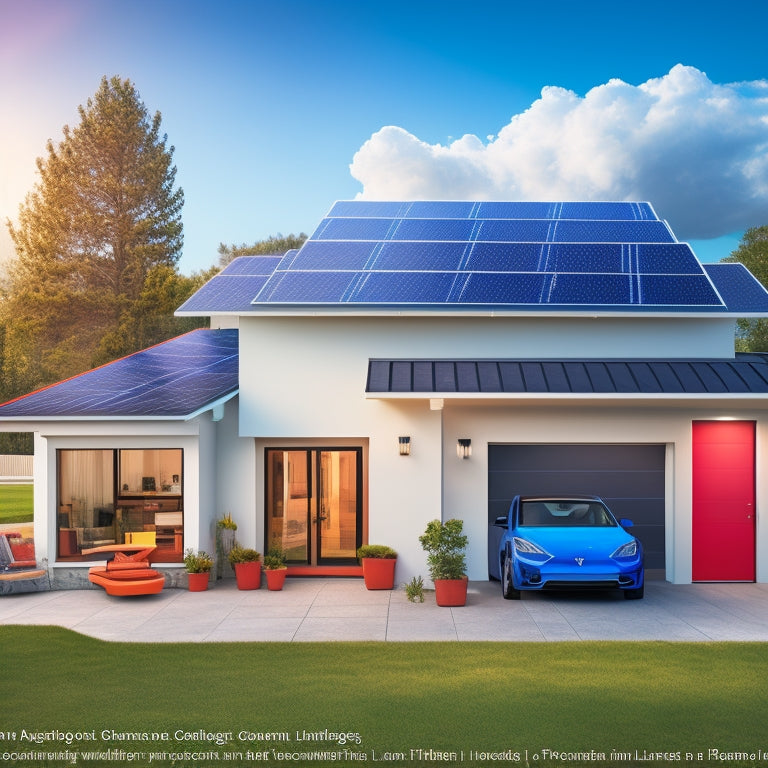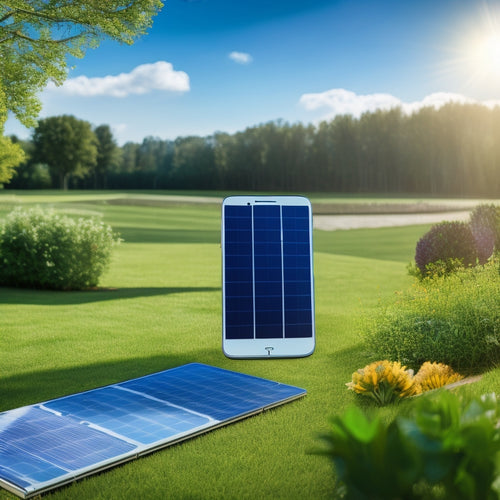
Comparing Top Home Battery Systems: Installation Guide
Share
You're considering a home battery system to utilize renewable energy and guarantee backup power during outages. With numerous options available, it's crucial to assess key factors like cost, efficiency, and durability. Top systems, such as Tesla Powerwall, LG Chem RESU, and SimpliPhi Power, offer varying cycle life, warranty, and capacity retention. As you manage installation and maintenance costs, consider system design, labor, permitting, and material expenses. You'll also want to investigate energy efficiency, savings, and battery management system features. By understanding these aspects, you'll be well-prepared to make an informed decision and optimize your home energy storage - and there's more to discover in your expedition to the perfect system.
Key Takeaways
- Consider factors like cost, efficiency, and durability when selecting a home battery system, with notable options including Tesla Powerwall, LG Chem RESU, and SimpliPhi Power.
- Assess your energy needs and load profiles to determine the required battery capacity, which is measured in kilowatt-hours (kWh) and influenced by depth of discharge (DOD).
- Evaluate the cycle life and warranty of each system, with Tesla Powerwall offering 5,000 cycles and 10-year warranty, LG Chem RESU providing 3,000 cycles and 10-year warranty, and SimpliPhi Power boasting 10,000 cycles and 10-year warranty.
- Ensure compatibility with solar panels by considering system sizing, future-proofing, and managing charge to prevent overcharging, with potential eligibility for federal funding and subsidies.
- Plan for installation and maintenance costs, including upfront expenses, battery replacement strategies, and ongoing maintenance fees, to optimize your home battery system's performance and savings.
Top Home Battery Systems Compared
When it comes to home battery systems, the market offers a wide range of options, each with its unique features, advantages, and disadvantages.
You'll find various battery types, including lithium-ion, lead-acid, and saltwater batteries, each with its own strengths and weaknesses. To make an informed decision, you should consider factors like cost, efficiency, and durability.
As renewable energy sources like solar energy become more prevalent, it's crucial to choose a battery system that can efficiently store excess energy for later use. User reviews can also provide important perspectives into real-world performance.
For example, Tesla's Powerwall is known for its sleek design and seamless integration, while LG's Chem RESU boasts high energy density and a long lifespan.
You'll need to weigh these factors against your specific needs and budget to choose the right system for your home.
Battery Capacity and Depth Discharge
Determine your energy storage needs by understanding battery capacity and depth of discharge, two critical factors in selecting the right home battery system.
Battery capacity, measured in kilowatt-hours (kWh), indicates the total amount of energy your system can store. Depth of discharge (DOD) refers to how much of that capacity you can use before needing to recharge.
When evaluating battery performance, consider the factors that influence solar battery prices, such as battery capacity and technology, which impact system performance, reliability, and cost. Load profiles guide capacity requirements, and higher capacity is needed for vehicles with high power demands or extended use.
When evaluating battery performance, consider the following key aspects:
- Energy density: A higher energy density means more power in a smaller package.
- Cycle efficiency: Look for high cycle efficiency to minimize energy loss.
- Rating consistency: Verify the manufacturer's rating aligns with real-world performance.
Cycle Life and Warranty Analysis
You're about to assess the lifespan and reliability of your home battery system, critical components that can make or break your energy storage investment. Cycle longevity and warranty coverage are key factors to take into account when choosing a home battery system. A longer cycle life means your battery will last longer and retain its capacity to store energy. Warranty coverage provides peace of mind, protecting your investment from unexpected failures or defects.
| System | Cycle Longevity | Warranty Coverage |
|---|---|---|
| Tesla Powerwall | 5,000 cycles | 10-year warranty, 70% capacity retention |
| LG Chem RESU | 3,000 cycles | 10-year warranty, 60% capacity retention |
| SimpliPhi Power | 10,000 cycles | 10-year warranty, 80% capacity retention |
When evaluating cycle life and warranty coverage, take into account your energy needs and usage patterns. A longer cycle life may be more important if you have high energy demands, while an extensive warranty can provide reassurance in case of unexpected issues.
Compatibility With Solar Panels
You'll want to verify your home battery system is compatible with your solar panels to maximize energy harvesting and storage.
When integrating solar panels, you'll need to take into account system sizing to balance energy production and consumption. By optimizing this collaboration, you can increase your energy independence and reduce your reliance on the grid.
Additionally, it's crucial to future-proof your business by adapting to regulations and consumer preferences, as seen in solar-powered EV charging, and utilize solar energy to reduce reliance on the grid and external sources.
Solar Panel Integration
Most home battery systems are designed to seamlessly integrate with solar panels, allowing you to store excess energy generated during the day for later use. This integration enables you to maximize your solar battery benefits and move closer to grid independence.
By leveraging renewable energy solutions, you can reduce your carbon footprint and contribute to a greener environment. Additionally, solar-powered EV chargers are eligible for federal funding and subsidies, making it a more affordable option.
Verify the battery system can manage the charge from your solar panels, preventing overcharging and optimizing energy storage.
-
Power flow management: The system should be able to prioritize energy distribution between your solar panels, battery, and home, guaranteeing efficient use of available energy.
-
Monitoring and control: Look for a system that provides real-time monitoring and control, allowing you to track your energy production, storage, and consumption, and make adjustments as needed.
System Sizing Considerations
When integrating a home battery system with solar panels, it's crucial to verify the system is properly sized to handle the energy output from your solar array.
To avoid energy waste or deficits, confirm your array sizing meets your EV charging needs, and consider ideal solar panel array design to enhance energy production.
You'll need to assess your load requirements and power needs to determine the ideal system size.
Consider your daily energy usage patterns, including peak demand periods and standby power requirements. This will help you determine the necessary battery capacity and inverter rating.
A properly sized system guarantees you can store excess energy generated during the day for use during the night or when the grid is down.
Energy Storage Synergy
Integrating your home battery system with solar panels releases the full potential of renewable energy. This collaboration enables you to capture energy from the sun and store it for later use, reducing your reliance on the grid.
With energy storage, you can optimize your energy management and enjoy grid independence.
Here are three key benefits of combining solar panels with home battery systems:
-
Maximized Energy Harvesting: Your solar panels can generate energy during the day, and your home battery system can store excess energy for nighttime use or during power outages.
-
Reduced Energy Waste: With energy storage, you can store surplus energy generated by your solar panels, reducing the amount of energy fed back into the grid and minimizing energy waste.
-
Enhanced Grid Independence: By storing energy generated by your solar panels, you can rely less on the grid and enjoy greater energy independence, giving you more control over your energy usage.
Installation and Maintenance Costs
You'll need to evaluate several expenses when installing a home battery system, including upfront installation costs, which can range from $5,000 to $20,000 or more, depending on the system's size and complexity.
Additionally, you'll need to factor in battery replacement expenses, as most batteries will need to be replaced every 10 to 15 years.
Ongoing maintenance fees, which may include regular software updates and occasional inspections, will also add to the system's overall cost.
Upfront Installation Costs
Your home battery system's upfront installation costs encompass not only the initial investment in the hardware and software but also the expenses associated with setting it up and guaranteeing it operates efficiently.
These upfront costs can vary depending on several installation factors, which you should consider when planning your home battery system.
Here are three key components that contribute to your upfront installation costs:
-
System design and engineering: This includes the cost of designing a custom system that meets your energy needs and guaranteeing it's compatible with your existing electrical infrastructure.
-
Labor and installation: This covers the cost of hiring a licensed electrician to install the system, which can vary depending on the complexity of the installation and local labor rates.
-
Permitting and inspection fees: You'll need to pay for necessary permits and inspections to guarantee your system meets local building codes and safety standards.
Battery Replacement Expenses
One essential aspect of home battery system ownership is planning for battery replacement expenses, which can greatly impact the overall cost of ownership.
You'll want to evaluate battery longevity strategies to maximize the lifespan of your batteries. This can include monitoring their health, updating software, and performing routine maintenance tasks.
Additionally, you should research recycling options for your batteries when they eventually need to be replaced. Many manufacturers offer take-back programs or recycling services, which can help reduce waste and minimize the environmental impact of your system.
Ongoing Maintenance Fees
Several key factors contribute to the overall cost of owning a home battery system, and ongoing maintenance fees are a crucial aspect to take into account.
As you consider your options, you'll want to understand the fee structures associated with ongoing maintenance. These fees can vary depending on the provider and the level of service you require.
Here are three key considerations:
-
Monitoring and troubleshooting: Some providers may charge a monthly or annual fee for remote monitoring and troubleshooting services.
-
Scheduled maintenance: Regular maintenance tasks, such as software updates and inspection, may incur a one-time or recurring fee.
-
Priority support: If you want priority access to technical support, you may need to pay an additional fee.
Energy Efficiency and Savings
As you consider home battery systems, it's essential to think about energy efficiency and savings, which can have a significant impact on your wallet and the environment.
By leveraging energy storage, you can reduce your reliance on the grid and enjoy energy independence. This means you'll be less affected by rate hikes and outages, giving you more control over your energy usage.
Furthermore, home battery systems can help minimize your environmental impact by storing excess energy generated from renewable sources like solar panels. This reduces the amount of energy wasted and lowers your carbon footprint.
Battery Management System Features
During the installation of your home battery system, a crucial component to contemplate is the battery management system (BMS), which guarantees the safe, efficient, and reliable operation of your energy storage solution.
The BMS plays an essential role in maximizing your battery's lifespan and performance.
You'll want to look for a BMS that offers:
-
Advanced battery monitoring, providing real-time data on your battery's state of charge, voltage, and temperature.
-
Multi-layered safety features, including overcharge and over-discharge protection, to prevent damage and guarantee safe operation.
-
Automated fault detection and alert systems, allowing you to quickly identify and address any issues that may arise.
Scalability and Upgradability Options
When designing your home battery system, you'll want to contemplate a solution that can adapt to your progressing energy needs. A modular design is crucial for scalability, allowing you to add or remove battery modules as your energy requirements change.
This future-proofing strategy guarantees your system remains efficient and cost-effective, even as your energy needs evolve. Look for systems that offer easy upgradability options, such as software updates or hardware swaps, to keep your system current with the latest technology.
This flexibility is essential for homeowners seeking energy independence, as it enables you to adapt to changing circumstances without replacing the entire system. By prioritizing scalability and upgradability, you'll enjoy a more sustainable and resilient energy solution.
Frequently Asked Questions
Can I Install a Home Battery System Myself?
You can attempt a DIY installation, but be aware of critical safety considerations, like electrical shock and fire risks, that may outweigh the cost savings, and consider whether your skills and knowledge are up to the task.
Are Home Battery Systems Compatible With Generators?
You'll be happy to know that most home battery systems are compatible with generators, thanks to advanced battery inverter compatibility and generator power management features that guarantee seamless integration and efficient energy distribution.
Do Home Battery Systems Work During Power Outages?
When the lights go out, you'll be the ruler of your domain, like a modern-day Atlas holding up the sky, as your home battery system kicks in, ensuring power reliability and extending battery lifespan during outages.
Can I Use a Home Battery System With a Wind Turbine?
You can definitely use a home battery system with a wind turbine, ensuring wind turbine compatibility and enhancing energy storage efficiency; this setup allows you to utilize and store renewable energy, granting you independence from the grid.
Will a Home Battery System Increase My Property Value?
You're likely to enhance your property value by up to 17% with a home battery system, according to a study by the National Renewable Energy Laboratory. As a savvy homeowner, you'll reap investment benefits, increasing your property's appeal and resale value.
Related Posts
-

7 Best Automated Sprinklers for Water-Wise Green Homes
You're likely among the 75% of U.S. homeowners who use in-ground sprinkler systems, and coincidentally, you're also c...
-

Why Transform Human Waste Into Garden Gold?
By changing human waste into garden gold, you'll reduce waste management costs, support sustainable agriculture, and ...
-

7 Best Solar Panel Upkeep Apps for Homeowners
You can optimize your solar panel's energy output and efficiency by up to 20% with regular maintenance, which is wher...


